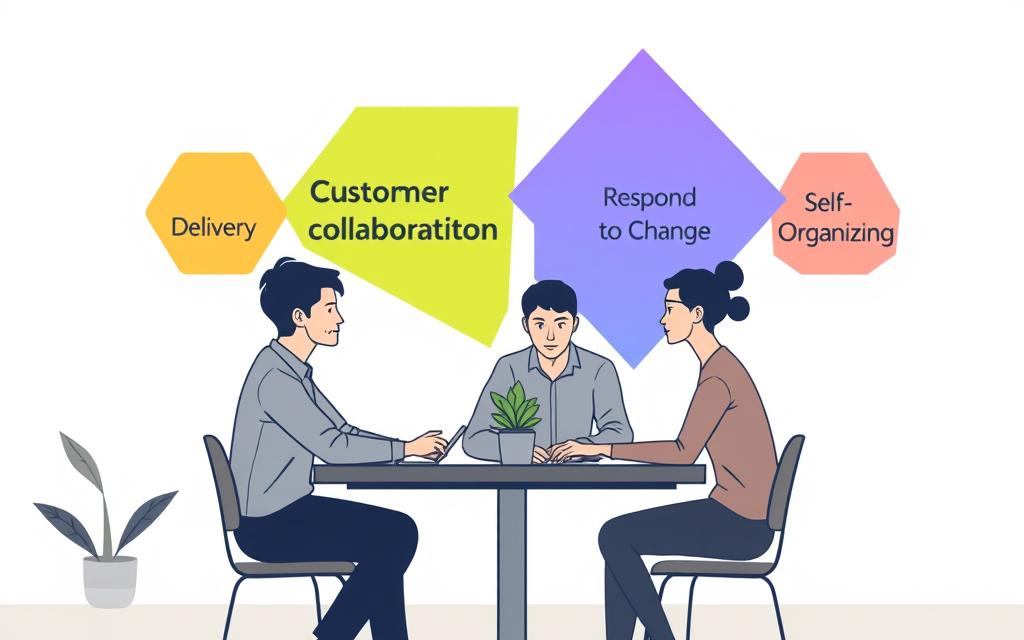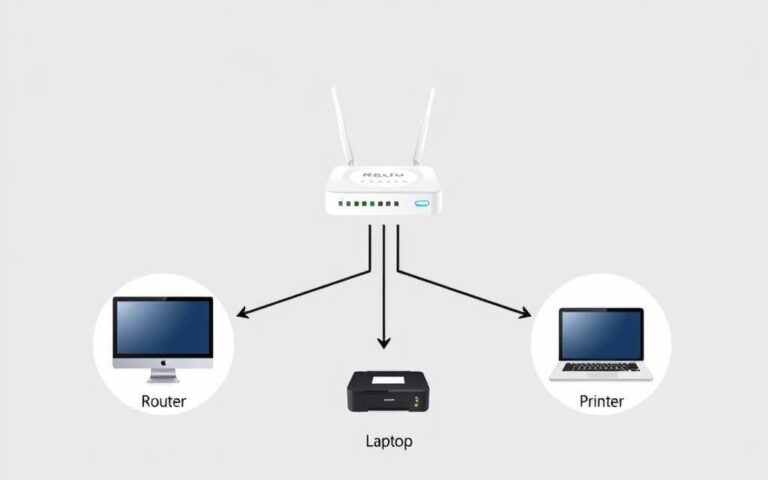What Is Agile in Technology A Guide to Agile Methodology
Today, tech teams use agile methodology to work faster and adjust to new needs. It’s different from old, strict ways of working. Agile focuses on working in small steps and making decisions together.
It started with the 2001 Agile Manifesto. This document puts people and feedback first, not strict rules.
Old ways of managing tech projects often take too long and don’t meet expectations. Agile changes this by breaking tasks into short sprints. This way, teams can improve their work based on real tests.
Tools like Asana show how this method lowers risks and keeps goals in sight.
Agile has four main ideas: value working software more than writing it down, work closely with those who matter, be open to changes, and trust teams to manage themselves. These ideas have changed how we make software, design products, and transform digitally.
For tech leaders looking into agile tech guide resources, knowing its flexibility is key. Agile’s strength is in being structured yet flexible. This is vital in today’s fast world. We’ll look at how to apply it, from planning sprints to reviewing them.
Understanding Agile Methodology in Technology
Today, tech teams don’t just use Agile; they live by its principles. This approach has evolved from factory floors to software studios. It’s now the core of tech innovation.
Defining Agile in the Tech Context
Agile started in the 1940s with Toyota’s lean manufacturing. It focused on cutting waste and quick changes. In the 1990s, software developers took these ideas and turned them into today’s Agile frameworks.
Historical evolution from manufacturing to software
In 2001, the Agile Manifesto made these practices official. It turned manufacturing’s efficiency into digital sprints. Now, we have short cycles for delivering software bits.
Waterfall methods are like assembly lines, with strict phases. Agile breaks this up with constant teamwork. For example, Atlassian teams finish features in 2-4 week sprints, not in one big release.
| Aspect | Waterfall | Agile |
|---|---|---|
| Project Structure | Linear phases | Iterative cycles |
| Client Feedback | End-stage only | Continuous integration |
| Risk Management | Late issue detection | Early course correction |
Why Technology Teams Choose Agile
74% of US companies use Agile because it solves real problems. Microsoft’s DevOps teams show how being flexible is key in fast-paced sectors.
Responding to rapidly changing requirements
Spotify’s engineers quickly adapted to new music licensing rules. Their squad model allowed for quick redeployment. This adaptive capacity is why 88% of tech leaders value Agile for staying on top of market changes.
Enhancing cross-functional collaboration
Breaking down silos helps solve problems faster. Amazon’s “two-pizza teams” show Agile’s focus on collective ownership of results, not just individual tasks.
“Agile isn’t a methodology – it’s a cultural reset button for tech organisations.”
Core Principles of Agile Development
Today’s tech teams use three key pillars for Agile methods. These focus on being flexible and delivering value. Let’s look at how these ideas help development teams.

1. Customer-Centric Iterations
Agile uses quick feedback loops to guide product growth. This keeps teams in tune with market needs and cuts down on waste.
Continuous delivery of working software
Teams release updates every 2-4 weeks. Asana’s team shows this with priority-based sprints. This lets stakeholders test early, avoiding costly changes later.
Embracing changing requirements
The Agile Manifesto values change over fixed plans. ADAPTOVATE’s test-and-learn method shows this, with 78% of teams seeing improved client satisfaction with mid-sprint changes.
2. Self-Organising Teams
Agile gives decision power to developers. This speeds up problem-solving and builds accountability.
Empowering developer decision-making
Atlassian’s Scrum ceremonies give engineers control over tasks. This makes teams 23% faster than traditional management, 2023 DevOps research shows.
Daily stand-ups and progress tracking
Quick syncs keep projects moving without extra hassle. A typical agenda includes:
- Work done
- Current tasks
- Blocks needing help
3. Sustainable Development Practices
Agile teams avoid burnout with careful workflow design. This balances work now with code health later.
Maintaining consistent work rhythms
Fixed-duration sprints create steady delivery patterns. Here’s a comparison of Agile and traditional methods:
| Metric | Agile Teams | Waterfall Teams |
|---|---|---|
| Release Frequency | 2-4 weeks | 6-12 months |
| Client Feedback Loops | Continuous | Post-launch |
| Scope Changes | Expected | Contract penalties |
Technical excellence through refactoring
Extreme Programming (XP) sets aside 20% of sprint time for code improvement. This keeps code healthy and prevents big problems from small issues.
Popular Agile Frameworks in Tech
Choosing the right Agile framework is key to a project’s success. Each method focuses on being adaptable, but they work differently. Scrum, Kanban, and Extreme Programming (XP) are the top choices for tech teams. They each have unique workflows for different challenges.
Scrum Methodology
The scrum framework breaks work into fixed sprints, usually 2-4 weeks. Teams use product backlogs to sort tasks and hold retrospectives to improve. Atlassian’s Jira makes planning sprints easy with its task boards.
Key Features
- Time-boxed iterations (sprints)
- Roles like Scrum Master and Product Owner
- Continuous improvement via retrospectives
Ideal Use Cases
Scrum is great for complex product development, like making enterprise software. Its set schedule helps teams handle changes without losing track of time.
Kanban Approach
The kanban workflow is different, focusing on visualising tasks with WIP (Work in Progress) limits. This stops bottlenecks by limiting how many tasks a team can do at once. Banks often use Kanban for maintenance projects needing quick updates.
Visual Workflow Management
Tasks move through stages like “To Do”, “In Progress”, and “Done”. Tools like Trello make this easy, helping teams work together well.
Best For
Kanban is perfect for continuous delivery settings, like IT support teams fixing urgent system issues.
Extreme Programming (XP)
XP programming focuses on technical quality with pair programming and tests. ADAPTOVATE’s studies show banks using XP for fraud detection systems where reliability is essential.
Emphasis on Technical Excellence
Developers write tests first, ensuring code is solid. Daily code reviews and quick releases help avoid mistakes in critical systems.
Typical Applications
XP is ideal for high-risk areas like aerospace software or medical device programming, where failure is unacceptable.
| Framework | Core Mechanism | Project Fit | Tools |
|---|---|---|---|
| Scrum | Sprints & Backlogs | Multi-phase products | Jira, Azure DevOps |
| Kanban | WIP Limits | Ongoing maintenance | Trello, Monday.com |
| XP | Pair Programming | Mission-critical systems | GitHub, CircleCI |
Benefits of Adopting Agile Practices
Companies that use Agile methods get 60% faster to market with key features. This change is not just about being quicker. It also changes how teams work together and deliver value in the tech world.

Business Advantages
Faster time-to-market for features is made possible by Agile’s cycles of improvement. Teams using Scrum can update every 2-4 weeks. This lets them quickly adapt to market changes.
Asana, for example, cut its feature deployment times by 43% while keeping quality high. This shows Agile’s power in making businesses more agile.
Improved stakeholder engagement comes from Agile’s open processes. Regular updates and feedback keep clients involved. ADAPTOVATE found that Agile teams get 35% higher customer satisfaction than traditional teams.
Technical Improvements
Higher code quality through continuous testing is Agile’s technical core. XP’s test-driven development spots 41% more defects early. This stops expensive fixes later and keeps development moving.
Reduced technical debt accumulation is made possible by regular code updates. Teams focus on Agile software development benefits and spend 15-20% of each sprint on maintenance. This reduces old system dependencies by 28% each year.
These clear benefits explain why 72% of tech leaders now require Agile for complex projects. Agile balances business needs with technical excellence. This creates a space where innovation can flourish without losing stability.
Challenges in Implementing Agile
Agile methods aim for quick delivery and teamwork. Yet, 47% of companies struggle to scale them, as ADAPTOVATE research shows. Success hinges on cultural shifts and avoiding incomplete framework adaptations.
Common Organisational Pitfalls
Teams often underestimate Agile’s impact on traditional ways of working. Leaders’ resistance to change, due to rigid hierarchies, clashes with Agile’s team focus.
Resistance to cultural change
ADAPTOVATE’s “failure wall” analysis found 68% of stalled transformations are due to middle management’s control. A Fortune 500 project manager shared:
“We approved sprint goals in quarterly meetings, undermining iterative development.”
Misapplication of hybrid methodologies
Hybrid methods combining Agile and Waterfall can be risky if not planned well. A 2023 study showed teams using Scrum with Gantt charts spent 23% more on documentation than pure Agile teams.
Effective Implementation Strategies
Atlassian’s State of Agile report shows successful organisations treat Agile adoption as change management, not just process tweaks.
| Challenge | Solution | Tool Example |
|---|---|---|
| Cultural resistance | Run department-specific pilot projects | Asana’s Agile template library |
| Hybrid confusion | Limit WIP (Work in Progress) | Atlassian’s Jira WIP triggers |
| Skill gaps | Certified Scrum Master coaching | Scrum Alliance training programmes |
Gradual adoption through pilot projects
Asana’s studies show teams starting with 6-week pilots adopt 40% faster. Focus on projects with:
- Clear success metrics
- Cross-functional volunteers
- Executive sponsorship
Investing in proper Agile coaching
Atlassian’s team enablement cut failed sprints by 31% through:
- Monthly coaching retrospectives
- Real-time Jira workflow audits
- Pair programming sessions
Conclusion
Agile methodology is key in digital transformation across many sectors. McKinsey research shows 89% of companies focus on Agile. It’s not just for software anymore; it’s for organisational strategy too. Companies like Anthropic use AI to make their Agile processes faster.
Adaptive organisations show Agile’s role in dealing with market changes. ADAPTOVATE’s data shows Agile teams respond 37% quicker to new rules. This flexibility is vital for handling cybersecurity threats and changing customer needs.
New Agile trends mix Scrum and Kanban. Tools like Asana’s Agile templates help teams follow ISO 21500 standards. This way, teams can keep delivering quality code continuously.
Technology leaders must mix automation with human skills. IBM’s 2023 index shows teams using AI and retrospectives get 42% more satisfaction. This mix of digital tools and teamwork is what makes modern organisations adaptable.
Resources from Atlassian and PMI help teams scale Agile wisely. By focusing on customer needs and sustainable workflows, businesses stay ahead in digital transformation.
FAQ
How does Agile methodology differ from traditional waterfall approaches in technology projects?
Agile uses flexible cycles instead of fixed phases. It lets teams adapt continuously. Unlike the waterfall method, Agile uses Scrum sprints for small, regular updates, like Spotify’s squads.
What role do customer feedback loops play in Agile development?
Agile focuses on what customers want through tools like Asana’s backlog. It ensures updates match what users need, cutting down on rework after launch.
Can Agile frameworks like Scrum scale for enterprise-level financial systems?
Yes, companies like ADAPTOVATE show Scrum can handle big projects. Atlassian’s Jira helps teams work together across different areas, keeping everything in line.
How does Agile address technical debt in long-running projects?
Agile uses XP to keep projects healthy through constant testing and improvement. Asana’s tools help teams balance adding new features with keeping things running smoothly.
What measurable business benefits do organisations gain from Agile adoption?
ADAPTOVATE found Agile cuts release times by 40% and defects by 65%. Asana users see a 30% jump in customer happiness with Agile’s focus on delivering important features.
Why do some technology teams struggle with Agile implementation?
Some teams find it hard to change to Agile because of cultural issues. ADAPTOVATE’s data shows this. But, with the right training and leadership support, Agile can stick.
How are modern tools like AI reshaping Agile methodologies?
Tools like Asana’s AI help plan tasks better using past data. Jira’s predictive tools warn of problems early. These tools make Agile better, but human teamwork is key.















